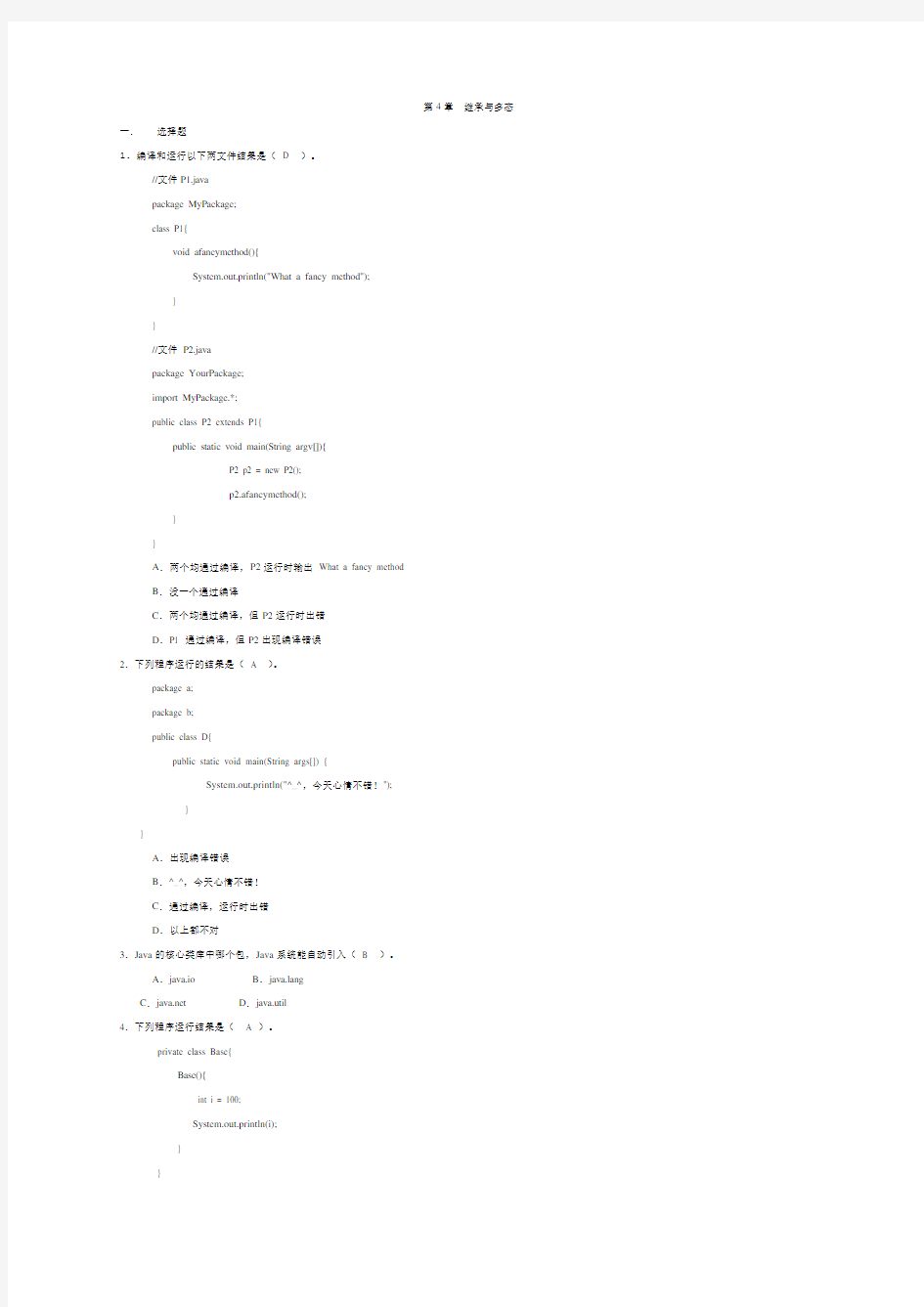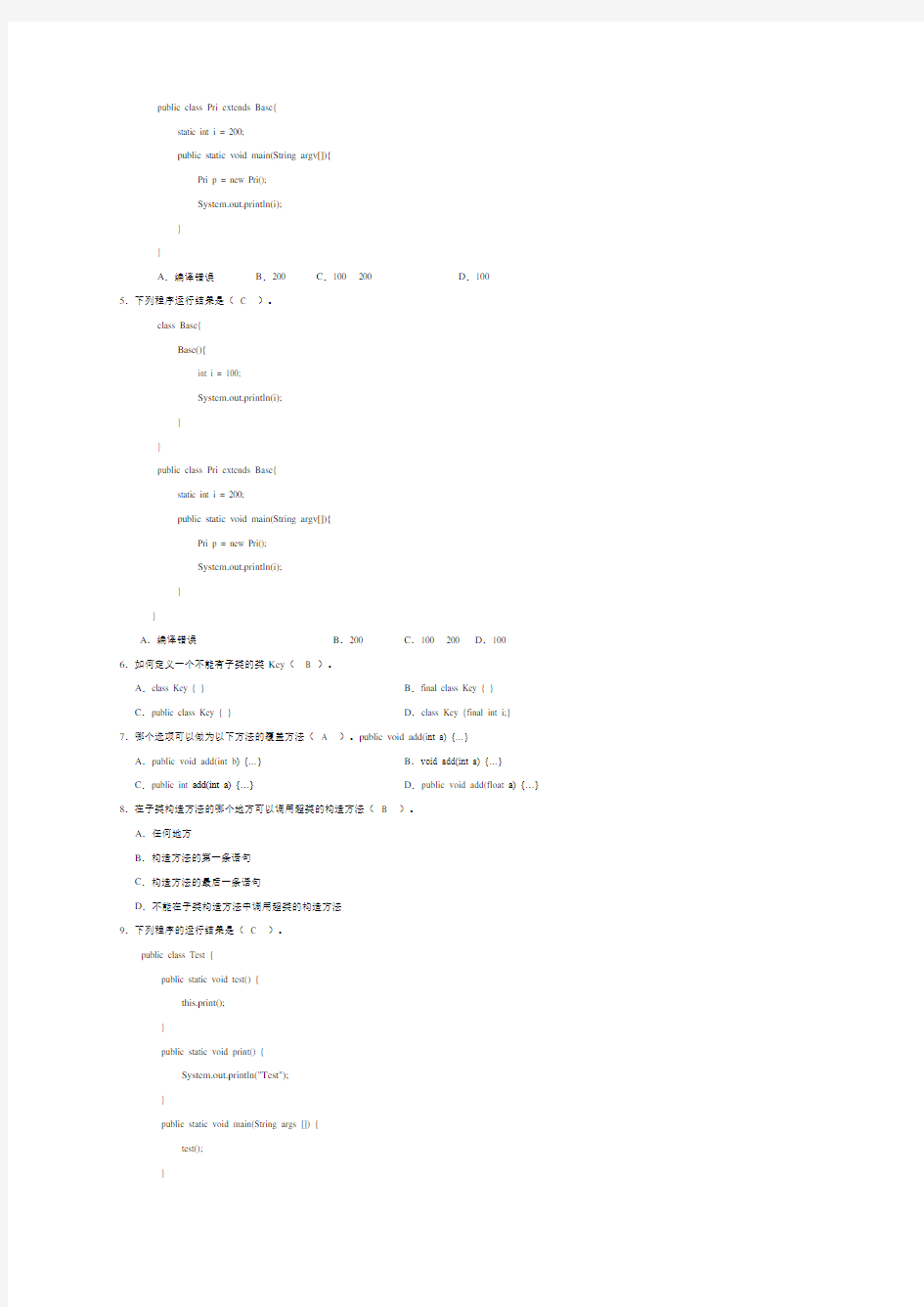

第4章继承与多态一.选择题
1. 编译和运行以下两文件结果是( D )。
//文件P1.java
package MyPackage;
class P1{
void afancymethod(){
System.out.println("What a fancy method");
}
}
//文件P2.java
package YourPackage;
import MyPackage.*;
public class P2 extends P1{
public static void main(String argv[]){
P2 p2 = new P2();
p2.afancymethod();
}
}
A.两个均通过编译,P2运行时输出What a fancy method
B.没一个通过编译
C.两个均通过编译,但P2运行时出错
D.P1 通过编译,但P2出现编译错误
2.下列程序运行的结果是(A )。
package a;
package b;
public class D{
public static void main(String args[]) {
System.out.println("^_^,今天心情不错!");
}
}
A.出现编译错误
B.^_^,今天心情不错!
C.通过编译,运行时出错
D.以上都不对
3.Java的核心类库中哪个包,Java系统能自动引入(B )。
A.java.io B.https://www.doczj.com/doc/ba6178622.html,ng
C.https://www.doczj.com/doc/ba6178622.html, D.java.util
4.下列程序运行结果是( A )。
private class Base{
Base(){
int i = 100;
System.out.println(i);
}
public class Pri extends Base{
static int i = 200;
public static void main(String argv[]){
Pri p = new Pri();
System.out.println(i);
}
}
A.编译错误B.200 C.100 200 D.100
5.下列程序运行结果是(C )。
class Base{
Base(){
int i = 100;
System.out.println(i);
}
}
public class Pri extends Base{
static int i = 200;
public static void main(String argv[]){
Pri p = new Pri();
System.out.println(i);
}
}
A.编译错误B.200 C.100 200 D.100 6.如何定义一个不能有子类的类Key( B )。
A.class Key { } B.final class Key { }
C.public class Key { } D.class Key {final int i;} 7.哪个选项可以做为以下方法的覆盖方法(A )。public void add(i nt a) {…} A.public void add(int b) {…}B.void add(int a) {…}
C.public int add(int a) {…}D.public void add(float a) {…} 8.在子类构造方法的哪个地方可以调用超类的构造方法(B )。
A.任何地方
B.构造方法的第一条语句
C.构造方法的最后一条语句
D.不能在子类构造方法中调用超类的构造方法
9.下列程序的运行结果是(C )。
public class Test {
public static void test() {
this.print();
}
public static void print() {
System.out.println("Test");
}
public static void main(String args []) {
test();
}
A.输出Test
B.无输出结果
C.类编译错误,指示不能在static上下文中使用this
D.以上都不对
10.设有如下代码:
1. class Example{
2. String str;
3. Example(){
4. str= "example";
5. }
6. Example(String s){
7. str=s;
8. }
9. }
10. class Demo extends Example{
11. }
12. public class Test{
13. public void f () {
14. Example ex = new Example("Good");
15. Demo d = new Demo("Good");
16. }
17. }
以下哪行将导致错误( D )。
A.第3行B.第6行C.第10行 D.第15行11.在Java中,如下的修饰符不是访问控制修饰符( A )。
A.static B.public C.protected D.private 12.试完成下述程序片段( D )。
public class Point{
int x,y;
public Point(int x,int y){
( )=x;
( )=y;
}
...
}
A.Point.x Point.y
B.无解
C.x1 y1
D.this.x this.y
13.在JAVA 中( C )。
A.一个子类可以有多个父类,一个父类也可以有多个子类
B.一个子类可以有多个父类,但一个父类只可以有一个子类
C.一个子类只可以有一个父类,但一个父类可以有多个子类
14.什么是在子类中创建一个和父类具有一样特征的方法,特征包括方法名字,参数个数,参数类型和方法返回值类型(A )。
A.覆盖(overloading) B.重载(overriding) C.继承(inheritance) D.none
15.哪个关键词在子类中用来访问与父类中一样的方法(A )。
A.super B.this C.static D.以上没有
16.哪个关键词用来引用当前类的对象(B )。
A.super B.this C.static D.以上没有
17.哪个修饰符定义的方法和变量只在定义它们的类中可见,而在其他的任何类中它们都不可见(C )。
A.protected B.public C.private D.none of the above
18.1. class Person {
2. public void printValue(int i, int j) {//... }
3. public void printValue(int i){//... }
4. }
5. public class Teacher extends Person {
6. public void printValue() {//... }
7. public void printValue(int i) {//...}
8. public static void main(String args[]){
9. Person t = new Teacher();
10. t.printValue(10);
11. }
12. }
第10行将调用的会是哪个方法( D )。
A.on line 2 B.on line 3 C.on line 6 D.on line 7
19.以下代码运行结果是(C )。
class Base {}
class Sub extends Base {}
class Sub2 extends Base {}
class CEx{
public static void main(String argv[]){
Base b = new Base();
Sub s = (Sub) b;
}
}
A.编译通过B.编译错误C.运行异常D.以上都不对
20.设有如下类定义:
class BaseWidget {
String name="BaseWidget";
void speak(){
System.out.println("I am a "+name);
}
}
class TypeAWidget extends BaseWidget{
TypeAWidget(){
name="TypeA";
}
以下哪段代码将正确编译和执行( B )。
A.Object a=new BaseWidget(); a.speak();
B.BaseWidget b=new TypeAWidget(); b.speak();
C.TypeAWidget c=new BaseWidget(); c.speak();
D.以上都不对
21.设有文件Derived.java中代码如下.
public class Base extends Object{
String objType;
public Base(){
objType="I am a Base type";
}
}
public class Derived extends Base{
public Derived() {
objType="I am a Derived type";
}
public static void main(String args[]){
Derived D=new Derived();
}
}
编译程序将出现何问题( B )。
A.将创建Base.class 和Derived.class 两个文件
B.编译程序将指示第1行有问题
C.编译程序将在第7行出错
D.以上都不对
22.哪种访问组合可放在第3行aMethod前和第8行的aMethod前(C )。
1. class SuperDuper
2. {
3. void aMethod() { }
4. }
5.
6. class Sub extends SuperDuper
7. {
8. void aMethod() { }
9. }
A.line 3: public; line 8: private
B.line 3: protected; line 8: private
C.line 3: private; line 8: protected
D.line 3: public; line 8: protected
23.以下类:
1. public class Base {
2. public void method(int i) {
3. System.out.print( "Value is" + i);
4. }
1. class Sub extends Base {
2. public void method (int j) {
3. System.out.print( "This value is" + j);
4. }
5. public void method(String s) {
6. System.out.print("I was passed " + s);
7. }
8. public static void main{String args[]) {
9. Base bl = new Base();
10. Base b2 = new Sub();
11. bl . method (5);
12. b2 . method (6);
13. }
14. }
Sub类的main方法的执行结果为( C )。
A.Value is 5Value is 6
B.This value is 5This value is 6
C.Value is 5This value is 6
D.This value is 5Value is 6
24.下列程序的运行的结果是(A )。
class parent {
void test() {
System.out.print("parent");
}
}
public class child extends parent {
void test() {
super.test();
System.out.print(" child");
}
public static void main(String args[]){
child x=new child();
x.test();
}
}
A.parent child B.child C.parent D.child parent 25.下列程序的运行的结果是(D )。
class parent{
parent(String s){
s="parent";
}
void test() {
System.out.print("parent");
}
public class child extends parent {
void test() {
super.test();
System.out.print(" child");
}
public static void main(String args[]){
child x=new child();
x.test();
}
}
A.parent child B.child C.parent D.编译错误26.下列程序的运行的结果是(D )。
class parent{
parent(String s){
s="parent";
}
void test() {
System.out.print("parent");
}
}
public class child extends parent {
child(String s){
s="child";
}
void test() {
super.test();
System.out.print(" child");
}
public static void main(String args[]){
child x=new child();
x.test();
}
}
A.parent child B.child C.parent D.编译错误27.看下列程序
package a;
class parent{
private int i=20;
protected int j=30;
public int k=40;
int h=50;
}
class child extends parent {
void f(){ }
在子类child的方法f()中不可以操作的变量是( A )。
A.i B.j C.k D.h 28.看下列程序
package a;
public class parent{
private int i=20;
protected int j=30;
public int k=40;
int h=50;
}
package b;
import a.parent;
class child extends parent {
void f(){ }
}
在子类child的方法f(A)中不可以操作的变量是( D )。
A.i B.j C.k D.h 29.看下列程序
package a;
class parent{
private int i=20;
protected int j=30;
public int k=40;
int h=50;
}
class child1 extends parent { }
class child2 extends child1{
void f(){ }
}
在子类child2的方法f()中不可以操作的变量是( A )。
A.i B.j C.k D.h 30.如下类的声明:
class A {}
则类A的父类是( C )。
A.没有父类B.本身C.Object D.Lang
31.下列程序的运行结果是(C )。
class parent{
int i=20;
int j=30;
void f(){
System.out.print(" "+i);
}
}
class child extends parent {
int k=40;
void f(){
System.out.print(" "+i);
}
void g(){
System.out.print(" "+k);
}
public static void main(String args[]){
parent x=new child();
System.out.print(x.i);
x.f();
child x1=(child)x;
System.out.print(" "+x1.i);
x1.f();
}
}
A.30 30 30 30 B.20 20 20 20 C.20 30 30 30 D.都不对
32.什么样的方法不能被重写(B )。
A.私有方法
B.最终方法(final方法)
C.受保护的方法
D.都不对
33.如果一个成员变量声明时必须赋给初值,而且不能再发生变化,那么这个成员变量是( B )。
A.私有变量
B.最终变量(常量)
C.受保护的变量
D.都不对
34.关于重载和重写的叙述正确的是(D)。
A.重载是多态的一种,而重写不是
B.重载是子类中定义的方法和父类中某个方法相同
C.重写是一个类中多个同名的方法,并且方法的参数不同
D.重写方法时不允许降低方法的访问权限
二.编程题
1.创建2个包:a和b。在包a中编写一个公共类A,类A中有:2个public double类型的属性c、d;一个构造方法public A(double x,double y)对c,d进行初始化;还有一个方法public double add()返回c与d的和。在包b中编写一个主类B,在类B的main方法中创建类A的对象e,
并用对象e调用方法add求2个数的和。
1.package a;
public class A {
public double c,d;
public A(double x, double y){
c = x;
d = y;
}
public double add(){
}
}
package b;
import a.A;
class B {
public static void main(String[] args) {
A e = new A(1,2)
System.out.println("两个数之和:" + e.add());
}
}
2. 编写一个类A,该类创建的对象可以调用方法f输出小写的英文字母表。然后再编写一个A类
的子类B,要求子类B必须继承A类的方法f(不允许重写),子类B创建的对象不仅可以调用方法f输出小写的英文字母表,而且可以调用子类新增的方法g输出大写的英文字母表。
最后编写主类C,在主类的main方法中测试类A与类B。
2.class A {
void f(){
System.out.println("A输出小写的英文字母表:");
char c;
for(c='a';c<='z';c++) {
System.out.print(" "+c);
}
System.out.println();
}
}
class B extends A{
void g(){
char c;
System.out.println("B输出大写的英文字母表:");
for(c='A'; c<='Z'; c++)
System.out.print(" "+c);
System.out.println();
}
}
class C{
public static void main(String args[]){
A a = new A();
B b=new B();
a.f();
b.f();
b.g();
}
}
3.编写一个Java应用程序,该程序包括3个类: A类、B类和主类E。其中类B是类A的子类,在子类B中新增了成员变量和成员方法,并且隐藏了父类A的成员变量和重写了父类A的成员
来测试上转型对象的一些特性。
3.class A {
int i=1;
int j=10;
void a(){
System.out.println("a of A");
}
void b(){
System.out.println("b of A");
}
}
class B extends A {
int j = 20;
int k =200;
void b(){
System.out.println("b of B");
}
void c(){
System.out.println("c of B");
}
}
class E {
public static void main(String[] args){
A a = new B();
System.out.println("a.i=" + a.i); //extends
System.out.println("a.j=" + a.j); //隐藏
a.a(); //extends
a.b(); //重写
}
}
4.编写一个Java应用程序,该程序包括3个类:类人猿类、People类和主类E。要求:1)类人猿中有个构造方法:类人猿(String s),并且有个public void speak()方法,在speak方法中输出“咿咿呀呀......”的信息。
2)People类是类人猿的子类,在People类中重写方法speak(),在speak方法中输出“小样的,不错嘛!”的信息。
3)在People类中新增方法void think(),在think方法中输出“别说话!认真思考!”。
4)在主类E的main方法中创建类人猿与People类的对象类测试这两个类的功能。4.class 类人猿{
类人猿(String s){ }
public void speak(){
System.out.println("咿咿呀呀......");
}
}
class People extends 类人猿{
super("");
}
public void speak(){
System.out.println("小样的,不错嘛!");
}
void think(){
System.out.println("别说话!认真思考!");
}
}
class E{
public static void main(String[] args){
类人猿yuan = new 类人猿("");
yuan.speak();
People p = new People();
p.speak();
p.think();
}
}